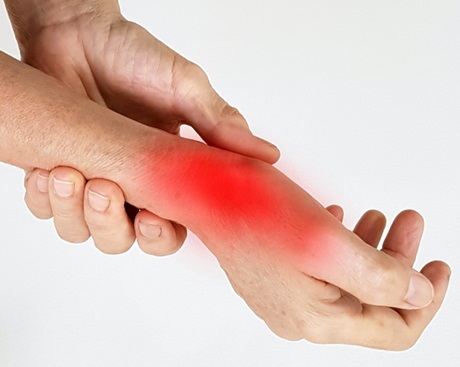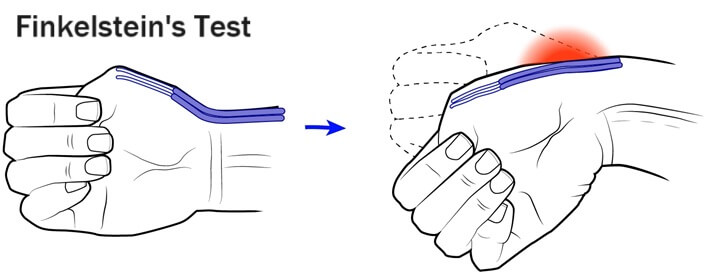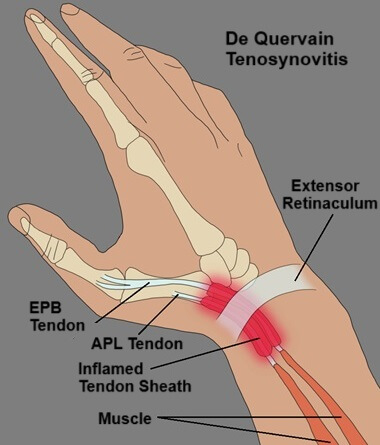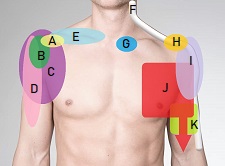- Home
- Wrist Pain Diagnosis
- Wrist Tendonitis
- De Quervain's
De Quervain Tenosynovitis
Written By: Chloe Wilson BSc (Hons) Physiotherapy
Reviewed By: SPE Medical Review Board

De Quervain Tenosynovitis is a condition that affects the tendons on the thumb side of your wrist. It causes pain and swelling, especially with hand movements.
De Quervain Syndrome can make simple tasks, such as gripping objects, writing, or lifting, incredibly uncomfortable. It is typically an overuse injury, but it can occur for a variety of reasons.
Your doctor may refer to it as De Quervain’s Syndrome, De Quervain Tendinitis or De Quervain’s tenovaginitis – they all refer to the same condition.
It is also sometimes referred to as "gamer's thumb" or "mommy thumb" because it commonly affects new parents who frequently lift their children and those who engage in repetitive hand movements, such as when texting or gaming.
In this article, we’ll look at what De Quervain tenosynovitis is, the common causes and symptoms, how it is diagnosed, and the most effective treatment options.
What is De Quervain Tenosynovitis?
De Quervain’s tenosynovitis affects two of the tendons in the wrist, abductor pollicis longus (APL) and extensor pollicis brevis (EPB) tendons.
These tendons help to control movements of the thumb. Tendons are thick, rope-like cords of strong, flexible tissue that connect muscles to bone.
The APL and EPB tendons pass through a sheath on the thumb side of the wrist that acts like a tunnel. This sheath acts a protective covering that allows the tendons to glide smoothly as you move your thumb and wrist.
With De Quervain tenosynovitis, the tendon sheath thickens and swells, causing the tunnel to narrow which restricts movement and increases friction.
As a result of this inflammation and thickening, the tendons are unable to move freely, leading to pain, stiffness, and a catching or sticking sensation during thumb or wrist movements. It is a common type of wrist tendonitis and the most common cause of radial wrist pain.
Causes of De Quervain Syndrome
Common causes of De Quervain tenosynovitis include:
- Repetitive Movements: Activities that require frequent wrist and thumb movement, such as typing, texting, or using hand tools, can lead to irritation and inflammation in the tendon sheath over time. The increase in smartphone usage and video gaming has led to more cases of De Quervain's Syndrome due to repetitive thumb motions (e.g. swiping, scrolling)
- Occupational or Recreational Overuse: Certain occupations that require lots of gripping or grasping work, like carpentry, sewing, or hairdressing, can put constant stress on the tendons. Hobbies like knitting, racket sports, gardening or playing musical instruments are also common triggers for De Quervain Tenosynovitis
- New or Increased Activity Levels: Sudden increases in physical activities, such as gardening, playing a new sport, or lifting weights, can cause inflammation in the tendons. De Quervain syndrome often affects new mothers as lifting and carrying a new-born repeatedly throughout the day can cause strain on the tendons, leading to what's often called "mommy thumb"
- Injury or Trauma: A direct injury to the wrist or thumb, or overuse in one event (like heavy lifting) can cause swelling and irritation of the tendons and resultant De Quervain’s tenovaginitis
- Arthritis or Inflammatory Conditions: People with rheumatoid arthritis or other inflammatory conditions may be more prone to developing De Quervain’s tenosynovitis due to joint and tendon inflammation
- Pregnancy: hormonal changes during pregnancy can cause fluid to build-up in the hands and wrist, leading to tenosynovitis
De Quervain Syndrome Symptoms
The symptoms of De Quervain tenosynovitis usually develop gradually but can worsen over time if left untreated.
Common De Quervain Syndrome symptoms include:
- Pain on the Thumb Side of the Wrist: The most common symptom is pain at the base of the thumb, extending up the wrist. This pain can also radiate up the forearm. De Quervain’s pain worsens with thumb and wrist movements, especially when lifting, gripping, pinching objects, using scissors or with twisting motions e.g. opening jars or turning door handles.
- Swelling: Swelling on the thumb side of the wrist is common, and the area may be visibly swollen or tender to the touch.
- Stiffness: You may notice reduced range of motion in your thumb or wrist, particularly when trying to extend or flex the thumb.
- "Catching" Sensation: Some people with De Quervain tenosynovitis experience a catching or sticking sensation when trying to move the thumb.
- Weakness in the Thumb: Over time, thumb strength may decrease, making it difficult to perform tasks like opening doors, lifting objects, or even typing.
De Quervain's symptoms usually develop gradually over time. If your symptoms started suddenly after an injury e.g. a fall, it is more likely that the pain is due to a scaphoid fracture. If your thumb (or fingers) keeps getting stuck in a bent position, it is more likely to be due to trigger thumb.
Diagnosing De Quervain Tenosynovitis
To diagnose De Quervain’s tenosynovitis, a healthcare professional will begin a review of your symptoms and a physical examination.
Diagnosing De Quervain Tenosynovitis typically involves:
1. History
Your doctor will start by asking you about your symptoms, when they started, what makes your symptoms better or worse and any previous injuries. They will also ask about your daily activities, occupation, or recent changes in routine to identify potential causes of tendon irritation.
2. Physical Examination
They will then carry out a physical examination, focusing on the thumb and wrist to assess pain, tenderness, swelling and any limitations in movement.
They will also carry out a special De Quervain’s Tenosynovitis Test, known as Finkelstein’s Test. It is simple and highly effective in determining if the condition is present.
Finkelstein’s test is carried out as follows:
- The patient makes a fist with their thumb tucked inside the other fingers.
- The doctor then asks the patient to bend the wrist toward the little finger (ulnar deviation).

If this movement causes sharp pain on the thumb side of the wrist, it’s a positive sign of De Quervain’s tenosynovitis. The test causes the inflamed tendons to stretch within the tendon sheath, triggering discomfort if the condition is present.
Finkelstein’s is the most commonly used De Quervain’s Tenosynovitis test and is extremely accurate.
3. Imaging Tests
While imaging is not always necessary, it may be used in certain cases to confirm the diagnosis of De Quervain’s Syndrome or rule out other conditions
- Ultrasound: This non-invasive test can provide a clear view of the tendons and confirm inflammation or thickening of the tendon sheath. Ultrasound is sometimes used to detect fluid build-up or other abnormalities within the tendon sheath.
- X-rays: Though X-rays cannot directly visualize soft tissue like tendons, they may be used to rule out fractures, bone spurs, or arthritis in the wrist or thumb joint.
- MRI: In rare or complex cases, an MRI might be ordered to provide a detailed look at the tendons, especially if other underlying issues (like a tendon tear) are suspected.
If you're not sure if this is sounding like your problem, check out the wrist pain charts or the radial wrist pain sections for help working out what is wrong. If your pain started after a fall onto an outstretched hand, it is most likely a scaphoid fracture.
#CommissionsEarned from Amazon on qualifying purchases
De Quervain Syndrome Treatments
De Quervain’s tenosynovitis treatment focuses on reducing inflammation, relieving pain, and restoring thumb function. In most cases, Mommy Thumb can be treated using conservative methods but, in rare cases, surgical intervention may be required.
Common De Quervain Syndrome treatments include:

- Bracing or Splinting: Wearing a De Quervains Tenosynovitis splint can be a really useful treatment tool. A thumb spica splint immobilizes the thumb and wrist, allowing the tendons to rest and heal. This is especially helpful during daily activities or while sleeping.
- Rest and Activity Modification: The first step in Mommy Thumb treatment is to rest the thumb and wrist, avoiding activities that trigger pain. Modifying tasks that strain the tendons, like using proper wrist mechanics or ergonomic tools e.g. keyboard pad, can help reduce symptoms.
- Ice Therapy: Applying ice packs to the affected area for 15–20 minutes several times a day can help reduce pain and swelling.
- Medication: Over-the-counter NSAIDs like ibuprofen/Advil or naproxen can help reduce inflammation and pain.
- Physical Therapy: A physical therapist can provide exercises and stretching routines to improve flexibility, reduce pain, and strengthen the muscles around the tendons.
- Corticosteroid Injections: If De Quervain’s pain persists despite conservative treatments, a corticosteroid injection may be recommended. This can quickly reduce inflammation and provide long-term pain relief.
De Quervain’s Tenosynovitis Surgery
In rare cases where other De Quervain’s syndrome treatments have failed and symptoms persist, surgery may be necessary to release the tight sheath around the tendons, allowing them to move freely.
This procedure, known as tenosynovectomy or De Quervain’s release, is typically highly effective, with minimal recovery time.
- De Quervain’s release is usually performed under local anesthesia, meaning you are awake but the area around the wrist is numbed.
- The surgeon makes a small incision (usually around 1–2 cm) on the thumb side of the wrist, directly over the location of the inflamed abductor pollicis longus (APL) and extensor pollicis brevis (EPB) tendons.
- The surgeon carefully identifies the extensor retinaculum (the tendon sheath), then cuts (releases) part of the sheath to relieve pressure on the tendons. They then check the tendons to ensure they can glide freely. If there’s any additional thickening, the surgeon may remove excess tissue around the tendons to ensure optimal movement.
- The incision is closed with stitches or sutures. A sterile dressing is applied to keep the area clean and to support healing. You will need to wear a splint for a few weeks following surgery.
De Quervain’s release surgery typically lasts between 20 to 40 minutes, and in most cases, it is an outpatient procedure, meaning you can go home the same day.
Preventing De Quervain Tenosynovitis
To prevent De Quervain tenosynovitis, consider the following strategies:
- Avoid Repetitive Movements: If possible, reduce or avoid activities that require repetitive thumb and wrist motions. If necessary, wear a wrist support or splint
- Use Proper Ergonomics: Whether working at a computer or performing manual tasks, ensure your wrists are in neutral positions e.g. with wrist pads, and take frequent breaks.
- Strengthen and Stretch: Regularly perform stretches and strengthening exercises to keep the tendons and muscles around the wrist and thumb healthy.
- Use Proper Techniques: When engaging in physical activities or sports, ensure that you are using proper techniques to avoid excessive strain on the tendons.
Frequently Asked Questions
What Causes De Quervain Syndrome?
What Causes De Quervain Syndrome?
Common causes of De Quervain tenosynovitis include:
- Repetitive thumb or wrist movement e.g. typing, texting, gaming
- Occupational or recreational overuse e.g. carpentry, knitting, hairdressing
- Sudden increases in activity levels e.g. new sports, weightlifting, gardening
- New mothers lifting and carrying new-borns "mommy thumb"
- Injury or trauma to the wrist e.g. wrist fracture
- Arthritis or inflammatory conditions e.g. rheumatoid arthritis
What Are The Common De Quervain Syndrome Symptoms?
What Are The Common De Quervain Syndrome Symptoms?
Common De Quervain’s disease symptoms include:
- Pain on the thumb side of the wrist, often radiating up the forearm: worsens with thumb and wrist movements.
- Swelling on the thumb side of the wrist, which may be tender to touch.
- Difficulty moving the thumb or wrist, including stiffness and a "catching" sensation.
- Pain worsens with activity, especially gripping, twisting, or repetitive thumb movements.
- Weakness in the thumb, making tasks like lifting or gripping challenging.
How Common Is De Quervain Tenosynovitis?
How Common Is De Quervain Tenosynovitis?
De Quervain syndrome is fairly common, affecting around 1% of the population in the US each year. It is the most common type of tenosynovitis.
Women are around six times more likely to experience De Quervain Tenosynovitis than men, and it is most common in people aged 30-50.
What Are The Best De Quervain Syndrome Treatments?
What Are The Best De Quervain Syndrome Treatments?
The best De Quervain tenosynovitis treatments are:
- Rest And Activity Modification: to avoid tendon strain and reduce symptoms.
- Ice Therapy: to reduce pain and swelling.
- Bracing or Splinting: thumb spica splint to immobilize the thumb and wrist for healing.
- NSAIDs: e.g. ibuprofen to manage pain and inflammation.
- Physical Therapy: for stretching, strengthening, and pain relief exercises.
- Corticosteroid Injections: to reduce inflammation and provide long-term relief.
- Surgery: (rare cases) to release the tendon sheath for improved mobility.
What Else Is De Quervain's Known As?
What Else Is De Quervain's Known As?
De Quervain Tenosynovitis is also known as De Quervain’s Syndrome, De Quervain Tendinitis, De Quervain’s tenovaginitis, Mommy Thumb or Gamer's Thumb - they all refer to the same condition.
De Quervain Summary
De Quervain tenosynovitis is a painful and often debilitating condition affecting the thumb and wrist.
It is commonly caused by overuse or repetitive strain, but with proper treatment, most people can fully recover without long-term issues.
Early diagnosis and appropriate management, such as rest, physical therapy, and, in some cases, corticosteroid injections, can significantly relieve symptoms and prevent the condition from worsening.
You may also be interested in the following articles:
- Radial Wrist Pain (Thumb Side)
- Ulnar Wrist Pain (Pinky Side)
- Wrist Tendonitis
- Wrist Fractures
- Carpal Tunnel Syndrome
- Wrist Pain Diagnosis Charts
Related Articles
Medical & Scientific References
- De Quervain Tenosynovitis. National Library Of Medicine
- Surgical Release of the First Extensor Compartment for Refractory de Quervain's Tenosynovitis: Surgical Findings and Functional Evaluation Using DASH Scores. Clinics In Orthopedic Surgery
- De Quervain's Disease: A Discourse On Etiology, Diagnosis & Treatment. PubMed Central
- Management Of De Quervain Tenosynovitis: a Systematic Review and Network Meta-Analysis. JAMA Network Open
Page Last Updated: January 29th, 2025
Next Review Due: January 29th, 2027




